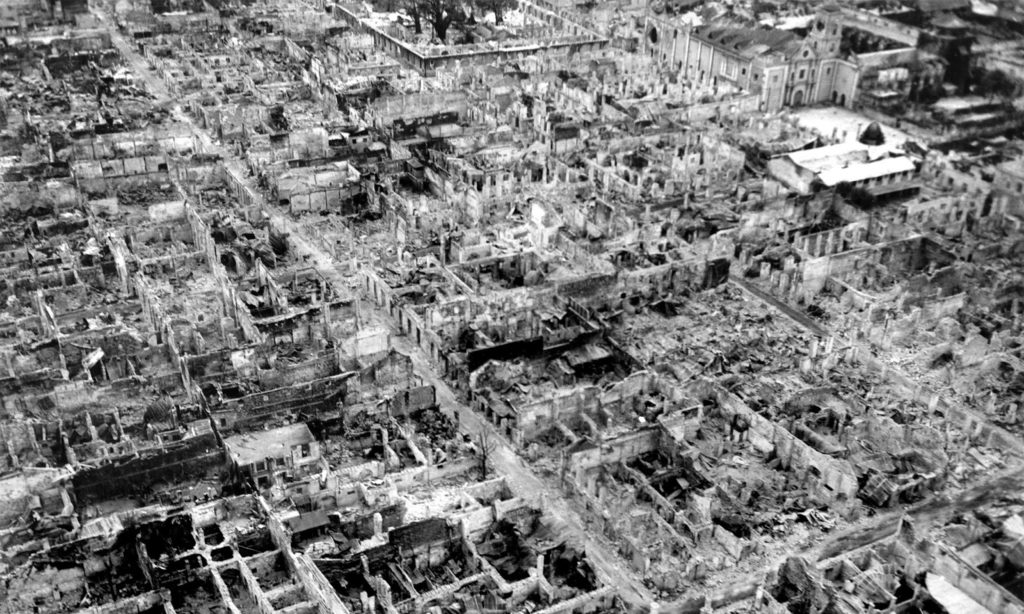Battle of Manila

My pleasure reading over the past two months has primarily been Ian Toll’s Pacific Triology. I’m into 1945 now, where Toll takes an unusually deep dive into the Battle of Manila, which inspired a three part series over at the Diplomat on the 76th anniversary of the battle. First part covers the basics:
Seventy-six years ago, the U.S. Army and the Imperial Japanese Army fought for control of Manila, resulting in the destruction of the city and the deaths of over 100,000 Filipino civilians. The Battle of Manila was the largest urban contest of the Pacific War between the United States and Japan, which was otherwise mostly fought on small, sparsely populated islands and in the wastes of the Pacific itself.
Memory of the massacre received attention during last year’s 75th anniversary, but the oncoming pandemic blunted much of the planned commemoration both in the United States and the Philippines.
Second part covers the big “what if,” which in this case involves what folks could have done to avoid the destruction of the city:
Could the destruction of the old city of Manila and the deaths of over 100,000 Filipino civilians have been avoided in February 1945? The question vexed planners at the time, and has been debated extensively in the years since.
First and foremost, the Imperial Japanese Army and the Imperial Japanese Navy could have declared Manila an open city and retreated to defensive lines that would not have needlessly endangered the safety of the civilian population and the city’s historical heritage.
And the third part covers the post-war legal fallout:
While the Battle of Manila has received less historical attention than the battles that immediately preceded and followed (Leyte, Iwo Jima, and Okinawa), it has come to occupy an inordinate place in the Law of Armed Conflict. In particular, the American decision to try and then execute Gen. Tomoyuki Yamashita established a standard for war crimes prosecution that remains controversial to the present.
Much legal work in the immediate aftermath of the war was geared toward ensuring that the crimes of the Axis, and sometimes even the Allies, would be subject to legal sanction in the future.
The question “why did the Americans need to take Manila?” animates and links the three pieces. Part of the answer is straightforward; there were compelling strategic and political logics for taking the Philippines rather than Formosa, and once that decision had been made it would have been extremely difficult to avoid invading Luzon and avoid seizing Manila. At the same time the destruction of Manila seems more wasteful than any other urban battle of World War II, given that it was not decisive to the outcome of the war in any meaningful way.
Toll frames the arguments for and against retaking the Philippines around an interesting dichotomy. Reputational concerns certainly drove MacArthur’s preference for the Philippines over Formosa, and also drove much of his operational thinking during the months long campaign, including a remarkably premature announcement of victory before the Battle of Manila had even begun, and the imposition of constraints on aerial bombing designed to save the city that, ironically, probably catalyzed greater overall destruction. More interesting, though, was how the argument of MacArthur and other advocates of the assault on the Philippines were received in the rest of the decision-making bureaucracy. MacArthur couldn’t simply bulldoze his way to agreement, and instead needed to frame his preferences in a way that was intelligible to the other major players (Nimitz, King, Arnold, Marshall, Spruance, Halsey, and Roosevelt). The idea that the United States had a special obligation to the people of the Philippines was taken seriously by planners, even as most acknowledged that the archipelago would return to US control at the point of Japan’s defeat, and that it would become independent shortly thereafter. That liberation was likely to inflict greater damage on the Philippines than simply leaving it under the control of the Japanese for another 6-8 months was not reckoned with as deeply as it should have been, and implicit recognition of this probably drove the vengefulness of the post-war prosecution of General Yamashita.
In any case, if you enjoy any part of the discussion above, I highly recommend the Toll trilogy.


